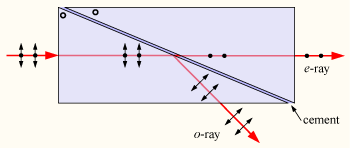
Glan-Thompson prism
Encyclopedia

Prism (optics)
In optics, a prism is a transparent optical element with flat, polished surfaces that refract light. The exact angles between the surfaces depend on the application. The traditional geometrical shape is that of a triangular prism with a triangular base and rectangular sides, and in colloquial use...
similar to the Nicol
Nicol prism
A Nicol prism is a type of polarizer, an optical device used to produce a polarized beam of light from an unpolarized beam. See polarized light. It was the first type of polarizing prism to be invented, in 1828 by William Nicol of Edinburgh...
and Glan–Foucault prisms. It consists of two right-angled calcite
Calcite
Calcite is a carbonate mineral and the most stable polymorph of calcium carbonate . The other polymorphs are the minerals aragonite and vaterite. Aragonite will change to calcite at 380-470°C, and vaterite is even less stable.-Properties:...
prisms that are cemented together by their long faces. The optical axes of the calcite crystals are parallel and aligned perpendicular to the plane of reflection. Birefringence
Birefringence
Birefringence, or double refraction, is the decomposition of a ray of light into two rays when it passes through certain anisotropic materials, such as crystals of calcite or boron nitride. The effect was first described by the Danish scientist Rasmus Bartholin in 1669, who saw it in calcite...
splits light entering the prism into two rays, experiencing different refractive indices
Refractive index
In optics the refractive index or index of refraction of a substance or medium is a measure of the speed of light in that medium. It is expressed as a ratio of the speed of light in vacuum relative to that in the considered medium....
; the p-polarized ordinary ray is totally internally reflected
Total internal reflection
Total internal reflection is an optical phenomenon that happens when a ray of light strikes a medium boundary at an angle larger than a particular critical angle with respect to the normal to the surface. If the refractive index is lower on the other side of the boundary and the incident angle is...
from the calcite-cement interface, leaving the s-polarized extraordinary ray to be transmitted. The prism can therefore be used as a polarizing
Polarizer
A polarizer is an optical filter that passes light of a specific polarization and blocks waves of other polarizations. It can convert a beam of light of undefined or mixed polarization into a beam with well-defined polarization. The common types of polarizers are linear polarizers and circular...
beam splitter
Beam splitter
A beam splitter is an optical device that splits a beam of light in two. It is the crucial part of most interferometers.In its most common form, a rectangle, it is made from two triangular glass prisms which are glued together at their base using Canada balsam...
. Traditionally Canada balsam
Canada balsam
Canada balsam, also called Canada turpentine or balsam of fir, is a turpentine which is made from the resin of the balsam fir tree of boreal North America...
was used as the cement in assembling these prisms, but this has largely been replaced by synthetic polymers.
Compared to the similar Glan–Foucault prism, the Glan–Thompson has a wider acceptance angle, but a much lower limit of maximum irradiance
Irradiance
Irradiance is the power of electromagnetic radiation per unit area incident on a surface. Radiant emittance or radiant exitance is the power per unit area radiated by a surface. The SI units for all of these quantities are watts per square meter , while the cgs units are ergs per square centimeter...
(due to optical damage limitations of the cement layer).

